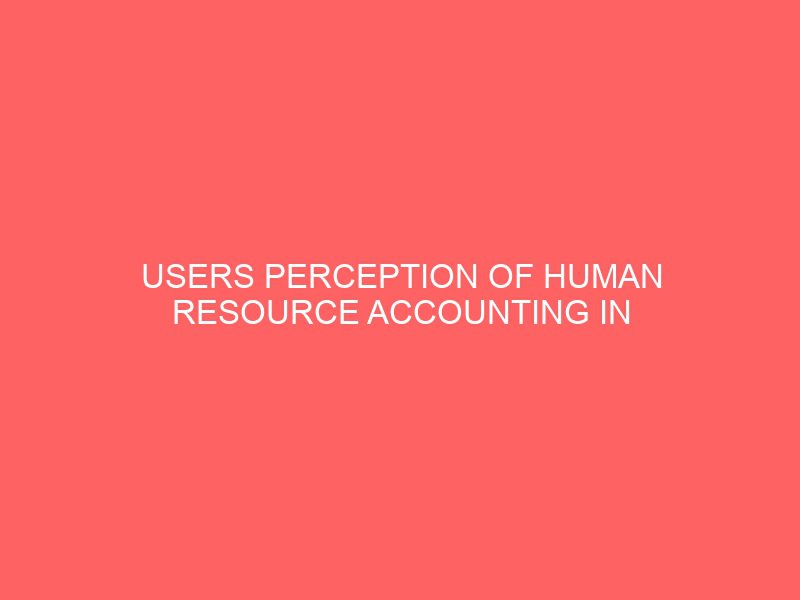Description
THIS RESEARCH WORK IS ON USERS PERCEPTION OF HUMAN RESOURCE ACCOUNTING IN NIGERIA.
ABSTRACT
This study was an investigation on users perception of human resource accounting in Nigeria with the aim of finding out of there is an objective way of valuing human resources (labour) in the financial statement of an organization in Nigeria. In pursuance of this objective, two hypothesis where formulated and tested.
To obtain appropriate data to test the hypothesis, 150 questionnaire was designed and administered to public limited liability company, macro finance bank, office of the Auditor general and Accountant in both Edo and Delta States respectively. The hypothesis were tested using the Jarque Bera statistical technique to determine users perception of human resource accounting in Nigeria.
The finding showed that human resource valuation and inclusion in the balance sheet affected user’s perception of the “true worth” of a business concern, Human resource valuation and inclusion in the balance sheet have a positive relationship in assessing the efficiency of human resources to productivity and consequently that human resource inclusion in the balance sheet will affect a company’s market value. Based on the findings the following recommendations were made. The relevant accounting bodies should establish a framework to aid the inclusion of human capital in the balance sheet and also on effective data collection system should be installed in organizations to enable them obtain accurate human resource information for decision making.
Researches should also be carried out in other parts of the country to enable us know the possibility of including human asset in the balance sheet of organization in Nigeria.
CHAPTER ONE
1.1INTRODUCTION
The study of human resources is as old as the study of Business activities. Early economists recognized the labour force and entrepreneur as fundamental factors for any production or services activity to take place, it is common to hear managers saying “our greatest asset is people”.
A review of the annual reports and financial statements of leading companies shows that the management team plays a major role in organizational performance. However, this class of assets in never given a proper treatment in the financial statement, instead accounting treatment of people are shown as cost (Amaefule, 2008).
The reason why human resource accounting should be rejuvenated at the present time, lies in the level of consensus which presently exist about the crucial role that employees play in all organizations’ (Roselender and Dyson, 1992:312). The consensus has been expressed in different ways by different authors, but some common threads can be identified.
Firstly, the changing structure of organizations, the importance of communications, the impact of technology, the need for continuous learning and the emergency of the knowledge workers, coupled with the rise in importance of the notion of intangible assets and intellectual capital (Casio, 1998; Boudreau, 1998; Mayo, 2000; Johanson and Learson, 2000, Roslender 1997).
Secondly, the globalization of competition where competing through cost is not enough and so, for many organizations, feature profitability lies in the skills and capabilities of employees, with the result that the development of people becomes the new source of competitive advantage. Sustainable growth comes through the organization’s ability to develop what are its most valuable rare and difficulty to imitate resources and to use these resources in what has become known as the ‘value based’ theory of competitive advantage (Sloman and Boudreau, 1999).
Thirdly, the measurement of an accounting for human resources into something of a renaissance is the view that organizations take seriously only what they can measure and measure the things only when they are serious about it. (Floreholtz, 2002).
Finally, the challenge is one of finding a way to value the intrinsic diversity in the worth of people (Mayo, 2002:5). While putting image of human resource accounting for many (Flamholtz, 1999:3) there is more to it than that although human resource accounting has been plagued by the difficulties of measurement, its aim is to accomplish two things: to provide a way of thinking about people as valuable organizational resources and to act as a decision making cool providing the necessary information to effectively manage and develop such a valuable resource (Flamholtz, 1999). In this respect, human resource accounting is clearly of much greater importance than simply finding a means of putting people on the balance sheet (Roslender and Dyson, 1992: 319).
1.2STATEMENT OF THE RESEARCH PROBLEM
The value of an enterprise as measured, written the traditional balance sheet, for example, building, production, plant and machinery etc. was viewed as a sufficient reflection of the enterprise’s worth. However, with the growing emergence of the knowledge economy, it has made this traditional valuation incomplete, which has led to the recognition that human capital is an increasing important part of an enterprise total value. This has led to the following questions:
Should human resources be included in the balance sheet?
Is there an objective way of such valuation?
If included will it affect the market value of the firm?
What are the cost implications of such valuation?
How will it affect the efficiency and profitability assessment of the firm?
The emergence method for human resource accounting is aimed at measuring, developing and managing the human capital in same enterprise can thus be said to reflect the need for improving, measuring and accounting practices as well as human resource management.
1.3OBJECTIVES OF THE STUDY
It has been conspreuously observed that most enterprises fail to include the human asset on the balance sheet of their organization.
The main objective of this study is: to examine whether the valuation and inclusion of human asset in the balance sheet will reflect changes of the ‘true” worth of a company.
Specific objectives will be: to examine whether there is an objective way to value human resources in an organization. To determine whether putting people on the balance sheet, is practicable in Nigeria.
To find out if given this additional information to managers will affect its decision making process.
To find out the cost benefit implication of human resource valuation.
To find out, whether the inclusion or non inclusion of human asset will affect users perception of a company’s financial statement.
1.4SIGNIFICANCE OF STUDY
Basically, human resource accounting is a management tool which is designed to assist senior management in understanding the long term cost and benefit implications of their human resources decisions so that better business decision can be taken. If such accounting is not done, then the management runs the risk of taking decisions that may improve profit in the short run but may also have severe repercussions in future.
The reason for developing human resource accounting in Nigeria are as follows:
Inadequacy of traditional balance sheet in providing sufficient information on organizational performance.
Measuring problems deriving from the valuation of human resources.
Redistribution of social responsibilities between the public and private sectors. Security versus flexibility in employment. Improved human resource management. Formal learning versus in-firm competency acquirement.
The focus of human resources accounting in enterprises in Nigeria, will lead t o a growing interest in the stakeholder that is, investors, employees, trade unions and government who will therefore gradually become aware of the potential of human resource accounting albeit from different perspectives. Therefore, making human resource accounting mandatory for enterprise along side financial statement. That is to say of human resource accounting is mandatory and regulated by law, the kind of information included will reflect in the financial statement, which will secure the interest of the employee at organizational level and improve the organization at large.
1.5STATEMENT OF RESEARCH HYPOTHESIS
Three null hypotheses and three alternative hypotheses were formulated for this study:
They are as follows:
Ho: Human asset valuation and inclusion in balance sheet
will not affect external users perception of a company’s worth.
H1:Human asset valuation and inclusion in balance sheet will affect external users perception of a company’s worth.
Ho:Human asset valuation in the balance sheet will have a negative relationship in assessing the efficient of human resources with respect to productivity.
H1:Human asset valuation in the balance sheet will have a positive relationship in assessing the efficient of human resources with respect to productivity.
Ho:Human resource inclusion in the balance sheet will not affect a company’s market value.
Hi:Human resource inclusion in the balance sheet will affect a company’s market value.
1.6SCOPE OF RESEARCH
The scope of this study is restricted to a public limited liability company, the lecturers of the department of Accounting, a micro finance bank and some selected individuals.
Since the entire enterprises in Nigeria cannot be covered, focus will be on a selected few, within Edo and Delta States.
This study will major on managers and employee with regards to the imperfection of the financial statement as it relates to human assets or capital of organization within Nigeria.
1.7LIMITATION OF RESEARCH
The limitation of the research are the imperfections or weaknesses of the study. A study of this nature would require a very large sample to avoid sampling errors, but due to the time and cost constraint, a smaller sampling consisting of two states (Edo and Delta) out of the thirty six states in Nigeria and also a targeted sample of 150 people out of the 150,000,000 people is used, which may affect the stability of the parameters of the study.









Reviews
There are no reviews yet.